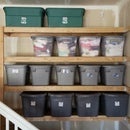Introduction: Palletable Workbench
I had a stack of pallets left over from laying sod this spring, and I've seen so many amazing things on Instructables built with them. So I figured "why not?" It would be my first pallet project and "it would be fun!" **
Tools Needed:
- Hammer
- Nail Setter
- Vise-Grips
- Wood Glue
- Sandpaper / Sander (100,150,220,400,800 grits)
- Wood Clamps
- Planer
- Miter Saw
- Measuring Tape
- Pencil
- Brackets
- Semi-Gloss Finish
- Circular Saw
- Level / Straight Edge
- Casters
- Screws (1, 3 inch)
Time to build:
I stopped counting after about 15 hours. A little ridiculous, to say the least. There's a very valid reason for this that I'll explain later. But lets just say if I had taken up a part time job delivering pizzas and simply worked those same hours, I'm very confidant I could have bought a set of diamond earrings for my wife or a really bad-ass workbench.
Direct Costs:
- Wood $0
- Casters $30
- Brackets $6
- Screws $5
- Glue $24
- Semi-Gloss $16
- 2" Bolts & Washers $5
total $86
Indirect Costs:
- 2 Planer Blades $36
- Circular Saw Blade $18
- Miter Saw Blade $42
- Insta-Care Copay $30
total $126
Lessons Learned about doing Pallet Projects $Priceless
Grand Total: $213 + taxes
Footnote:
** Although I have a fair amount of experience with woodworking, I remind you, this was my first time doing a pallet project, ever.
Step 1: Disassemble Pallets
At this point I wasn't sure yet what I was going to build, but they needed to pulled apart regardless and doing so give me some "think time" to get a few ideas.
I found the best way of doing this is with a hammer and nail puller.
Step 2: Pulling Out Nails
After all the boards are separated you'll spend a considerable amount of time getting out millions of nails. Literally MILLIONS.
This should have been the"Red Flag", setting off all sorts of alarms in my head telling me to stop and abandon ship. But no. I looked onward like a naive, virgin who just scored a date, unwittingly with a 10/10 on the Hot / Crazy Matrix.
These boards had very rough edges so I needed to get as many nails out as possible to get through a planer.
In the pictures above I show how I used a nail setter and vice grips to remove some of the nails that had been cut off due to their previous pallet lifestyle and being re-purposed multiple times.
Step 3: Barely Palletable (Pun)
After a couple hours of removing nails, I was still left with many many nails that were cut off and not protruding out anywhere making them extremely difficult to pull. So I begrudgingly decided to use the nail setter to set them below the surface clear from that path of the planer.
Notice that pile of boards in the picture above..? Each one of them has 12-14 nails on each side!
Do you understand my reluctance now..? But being a "nice guy," no longer being a virgin and feeling committed to my 10/10 Hot/Crazy date, I carried on.
I won't begin to tell you how long this took me. I don't know, it's all a haze to me. It has become a suppressed memory. When spoken of, my eyes tear up and I get lumps in my throat... We won't go there.
Step 4: The Good, the Bad, and the Ugly
After getting out some nails, It's a good idea to sort out what pieces are usable and which ones are junk. I broke then down into 3 categories: The good, bad and ugly.
Step 5: Planing
At this point I was feeling very optimistic, thinking the worst was far behind me. But I wasn't in the clear yet. There's still a few more rounds to go before this fight is over. (Did you happen to notice the hospital copay listed under the Indirect costs section?)
I managed to square up the boards after several runs through the planer at 1/16 - 1/8 cut per run.
Despite all my efforts trying to clean these things up, I still managed to hit several nails, burning out the blade (Blade #1).
Step 6: Crowning
In this step I simply found the direction each board bowed in and set them all together. They're easier to work with later on if they are all bowing together in the same direction.
The best way to determine this is to use a straight edge like a level.
Step 7: Gluing
In order to fit the planer the boards need to be divided into groups. I have 4 groups with 9 boards each.
Keeping careful track of the direction they all bow in, I laid them out and spread a generous amount of glue all over them except for one (the end piece).
I used the equivalent of three 16 oz. bottles. Granted, most of the glue gets pressed out then they're clamped together but I'd rather error on the safe side with a little extra than not enough. (Truthfully, after using 3/4 of this first bottle on the first group I just went out and bought a 1 gallon jug from Lowe's for $28 giving me plenty left over for the same price).
All my research lead me to conclude that Titebond Ultimate 3 is the best glue out there for this kind of project. It takes about 30 mins to setup which is nice when working with several pieces.
Once all glued, stack them back up and clamp them all up with tons of little clamps. Making sure the boards are aligned properly and starting in the middle lock each one in place, going back and re-tightening the others as you progress.
Add as many clamps as necessary, but I wouldn't do any less than 2 per foot. Personally, I prefer every 6-8 inches.
Each block should set for 24-48 hours before applying any loads.
Step 8: Planing Each Group
Feeding each bundle through the planer several times at 1/8 inch increments you'll eventually get to where they're all smooth and at a uniform thickness. You'll need to do each side but finish one side completely before switching. Also, start with the flattest side facing down. Doing this will help improve the squareness of the cuts.
Again, I ran into million of nails ending the life of my second blade. (Blade #2) It was at this point I sliced open my finger changing out the blade. Yes, I do have pictures and they are reserved for the very end.
Step 9: Chop Off the Ends
Square them up as best you can and cut off then ends. Technically you can wait to do this but I wanted to get some squareness going in order to gauge some of my other measurements.
More nails killed blade. (Blade #3)
Step 10: Tighten the Gap
The gaps between each block was a little off showing that me edges weren't quite square enough. So I had to improvise with a makeshift track saw using a circular saw ans a straight edge. It was a little finicky but I was able to shave off the edges and make a pretty square edge. Although a hassle and not always perfect, I was quite impressed with the results. You can see from the pictures above how tight the gaps are.
Idealy a table saw, track saw, or jointer would be the best tool for this job (all of which are $300 and up).
Needless to say, I really killed the blade on this one. At this point, I was cutting through so many nails my wife came out to the garage to see what all the smoke was about! (Blade #4)
Step 11: Gluing the Blocks Together
The best clamps for this are pipe clamps. They are stronger and don't flex as easily. The clamps I used are from Harbor Freight for $10 each. You'll still need 3/4" pipes at whatever length. Mine are 48".
Position the blocks on the clamps and stand them on edge for gluing. By standing them up, the glue will stay put on the surface and won't run off while you're prepping the next block.
Once done, lay them down and firmly clamp them together beginning in the middle. It's best to alternate the sides each clamp is on ensuring more even pressure throughout. As you can see from my pictures I didn't do this properly.
This should set for 24-48 hours before applying any load.
Step 12: Building the Legs
I used a combination of glue and screws to secure the boards together. Then I used more clamps to form a tight connection of their surfaces since each board had some warping and didn't flush up well.
Step 13: Forming the Stand
After cutting the legs to size, I began forming the stand for the bench top.
Best way to do this is to:
- Match up the 4 corners as flush as you can.
- Put only once screw per corner.
- Measure each diagonal, and adjust.
- When diagonal lengths are the same set the remaining 4 screws.
Setting only 1 screw in each corner allows the wood to pivot enough to square up your diagonals. Then setting the remaining 4 screws secures the frame in a square position.
After completing this for both sides you'll do the exact same thing in flushing the corners with 1 screw initially then securing them with the rest of the screws after squareness is obtained.
Use clamps and levels to help hold boards in position while doing this. It'll help keep things still while you're moving around.
Step 14: Mounting the Casters
The best place to position the casters is directly under the legs. This transfers all of the load and/or forces directly through and reducing any internal stresses on the frame.
I wanted a little more substance to bolt into so I added an additional board. It adds some height to the table but I already accounted for this in my designs.
With this wood I've been pre-drilling all my holes just to avoid any splitting.
I set them with 2" x 1/4" Bolts with washers & lock washers.
Step 15: Squaring Up the Top
I used a large T-Square to get a straight line that's square to the other sides.
Here again I used the improvised "Track Saw" method, demonstrated in step 10, to get a nice edge on the table.
Step 16: Securing Top to Bottom
After measuring the overhang on each side and satisfied that it's positioned evenly, I again clamped the top to bottom to assure no movement while attaching the brackets.
Step 17: Sand
Even with all the planing the joints between each block didn't quite line up, so I used a belt sander (only in the direction of the grain) 100 grit sandpaper to work down some of these edges. Then you can use a random-orbital sander with a 220 grit to smooth things down a bit.
When you're all done sanding use a damp cloth or air compressor to blow off all the dust.
Step 18: Semi-Gloss
Apply a generous coat of semi-gloss, allowing an extra little bit to seep into the cracks and holes. Give about 24-48 hours to dry. Then use a 400 grit to de-nib the surface. Give it a second coat and de-nib with an 800 grit paper and you're done!
Step 19: Final Product
Step 20: Insta-Care Visit
I got this while changing the planer blade for the second time. I was trying to rush things and got careless... 4 stitches later I was back on track. I was just going to superglue it closed but this was to the bone so I'm glad I when in.

Second Prize in the
Wood Contest

Participated in the
On a Budget Contest













